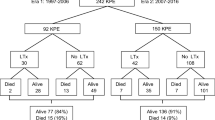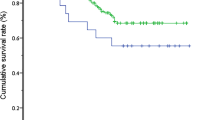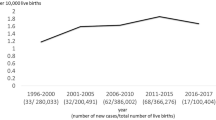Abstract
Objective
To study the outcome of Biliary atresia after Kasai's portoenterostomy and clinical and biochemical factors affecting the outcome.
Methods
Medical record review of patients of biliary atresia operated from January 2000 to December 2014. The following data were collected and analyzed - sex, age at surgery, liver function tests, associated congenital anomalies, and clearance of jaundice (at 3 months). Final outcome was classified as alive, dead, or jaundice-free at last follow-up (minimum 1 year).
Results
121 patients (61.9% males) were included; 32 (26.5%) were lost to follow-up at 1 year. At last follow-up, out of the 89, 42 (47.2%) were alive, 29 (32.6%) were jaundice-free, and 47 (52.8%) had died. The native liver survival rate at last follow up was 43.8%. 42 (47.2%) patients had complete clearance of jaundice at 3 months post-procedure. Jaundice-clearance rate was significantly high in patients alive (83.3% vs 16.7%, P<0.001)) as compared to those who died later.
Conclusion
Jaundice clearance at 3 months post surgery is a good early indicator of long term success.
Similar content being viewed by others
References
Sokol RJ, Mack C, Narkewicz MR, Karrer FM. Pathogenesis and outcome of biliary atresia: current concepts. J Pediatr Gastroenterol Nutr. 2003;37:4–21.
Davenport M. Biliary atresia: Outcome and management. Indian J Pediatr. 2006;73:825–8.
Shneider BL, Brown MB, Haber B, Whitington PF, Schwarz K, Squires R, et al. A multicenter study of the outcome of biliary atresia in the United States, 1997 to 2000. J Pediatr. 2006;148:467–4.
Chardot C, Carton M, Spire-Bendelac N, Le Pommelet C, Golmard JL, Auvert B. Prognosis of biliary atresia in the era of liver transplantation: French national study from 1986 to 1996. Hepatology. 1999;30:606–11.
Sokol RJ, Shepherd RW, Superina R, Bezerra JA, Robuck P, Hoofnagle JH. Screening and outcomes in biliary atresia: summary of a National Institute of Health Workshop. Hepatology. 2007;46:566–81.
Davenport M, De Ville de Goyet J, Stringer MD, Mieli-Vergani G, Kelly DA, McClean P, et al. Seamless management of biliary atresia in England and Wales (1999-2002). Lancet. 2004;363:1354–7.
Jimenez-Rivera C, Jolin-Dahel KS, Fortinsky KJ, Gozdyra P, Benchimol EI. International incidence and outcomes of biliary atresia. J Pediatr Gastroenterol Nutr. 2013;56:344–54.
Tiao MM, Tsai SS, Kuo HW, Chen CL, Yang CY. Epidemiological features of biliary atresia in Taiwan, a National study 1996-2003. J Gastroenterol Hepatol. 2008;23:62–6.
de Carvalho E, dos Santos JL, da Silveira TR, Kieling CO, Silva LR, Porta G, et al. Biliary atresia: the Brazilian experience. J Pediatr (Rio J). 2010;86:473–9.
Wildhaber BE, Majno P, Mayr J, Zachariou Z, Hohlfeld J, Schwoebel M, et al. Biliary atresia: Swiss national study, 1994-2004. J Pediatr Gastroenterol Nutr. 2008;46:299–307.
Serinet MO, Broué P, Jacquemin E, Lachaux A, Sarles J, Gottrand F, et al. Management of patients with biliary atresia in France: Results of a decentralized policy 1986-2002. Hepatology. 2006;44:75–84.
Gupta L, Bhatnagar V. A study of associated congenital anomalies with biliary atresia. J Indian Assoc Pediatr Surg. 2016;21:10–3.
Narsimhan KL, Chowdhry SK, Vaiphei K, Samujh R, Mahajan JK, Thapa BR, et al. Outcome of biliary atresia from Chandigarh: results of a prospective analysis. Indian Pediatr. 2001;38:1144–8.
Sanghai SR, Shah I, Bhatnagar S, Murthy A. Incidence and prognostic factors associated with biliary atresia in Western India. Ann Hepatol. 2009;8:120–2.
Ramachandran P, Safwan M, Srinivas S, Shanmugam N, Vij M, Rela M. The extended Kasai portoenterostomy for biliary atresia: A preliminary report. J Indian Assoc Pediatr Surg. 2016;21:66–71.
Author information
Authors and Affiliations
Corresponding author
Rights and permissions
About this article
Cite this article
Redkar, R., Karkera, P.J., Raj, V. et al. Outcome of biliary atresia after Kasai’s portoenterostomy: A 15-year experience. Indian Pediatr 54, 291–294 (2017). https://doi.org/10.1007/s13312-017-1091-5
Received:
Revised:
Accepted:
Published:
Issue Date:
DOI: https://doi.org/10.1007/s13312-017-1091-5




